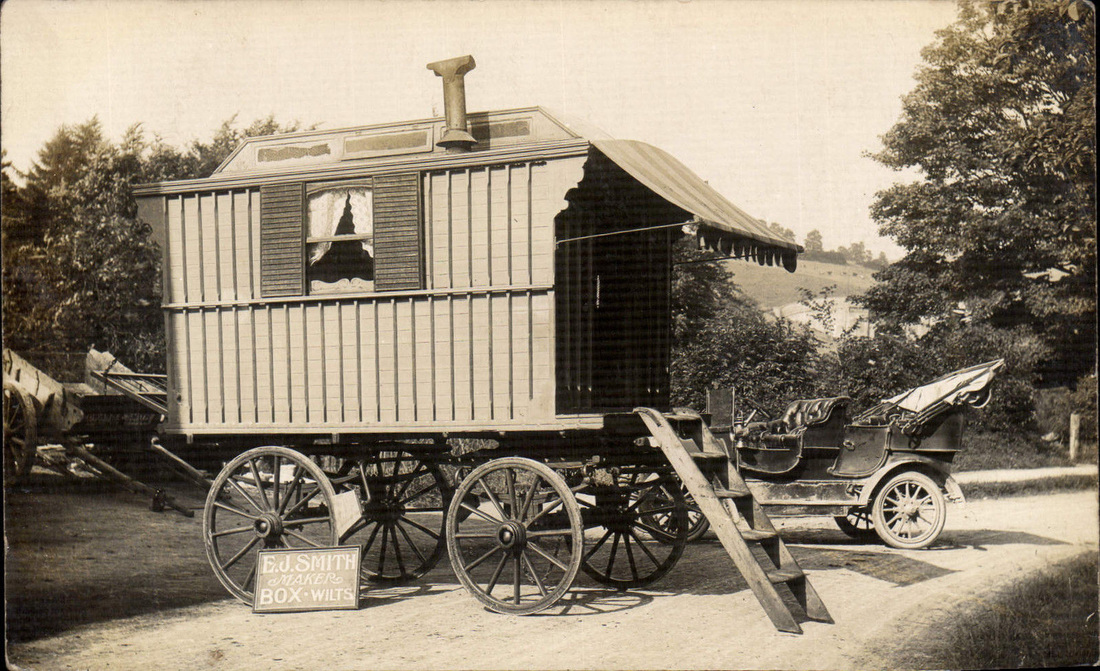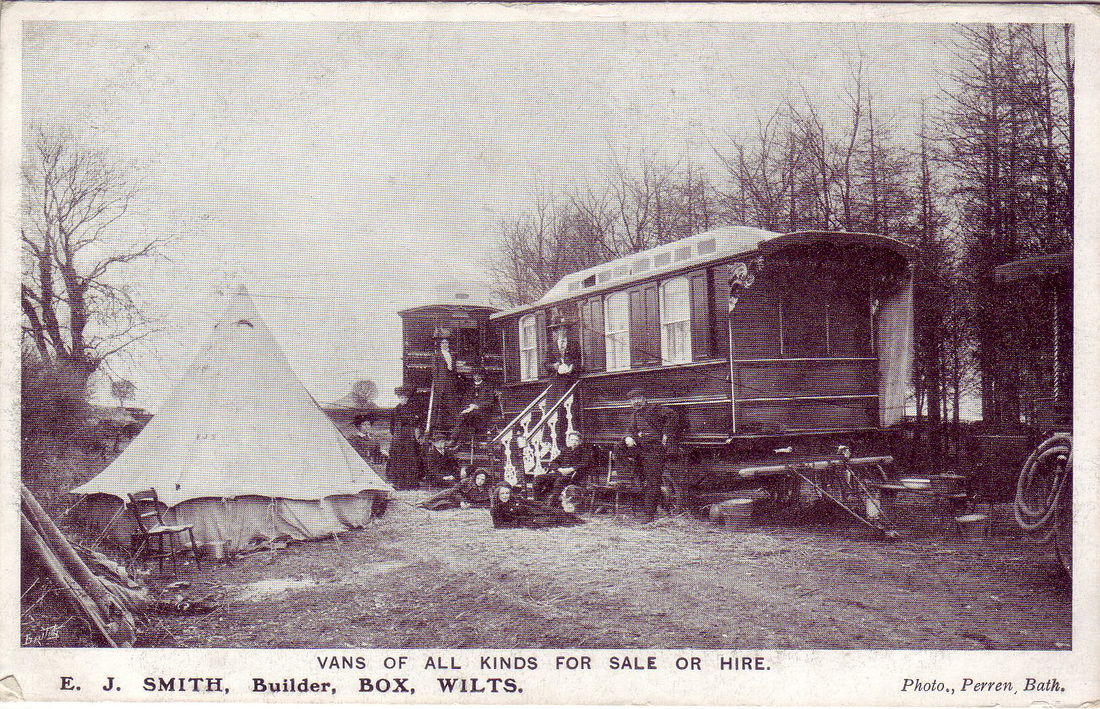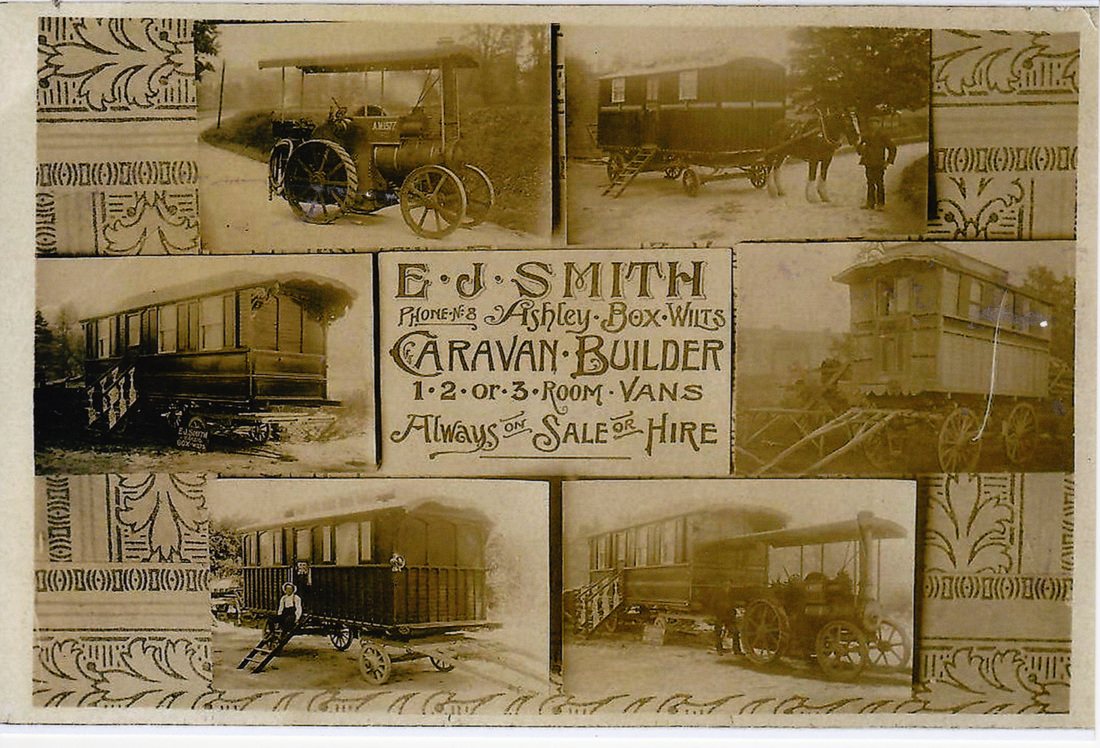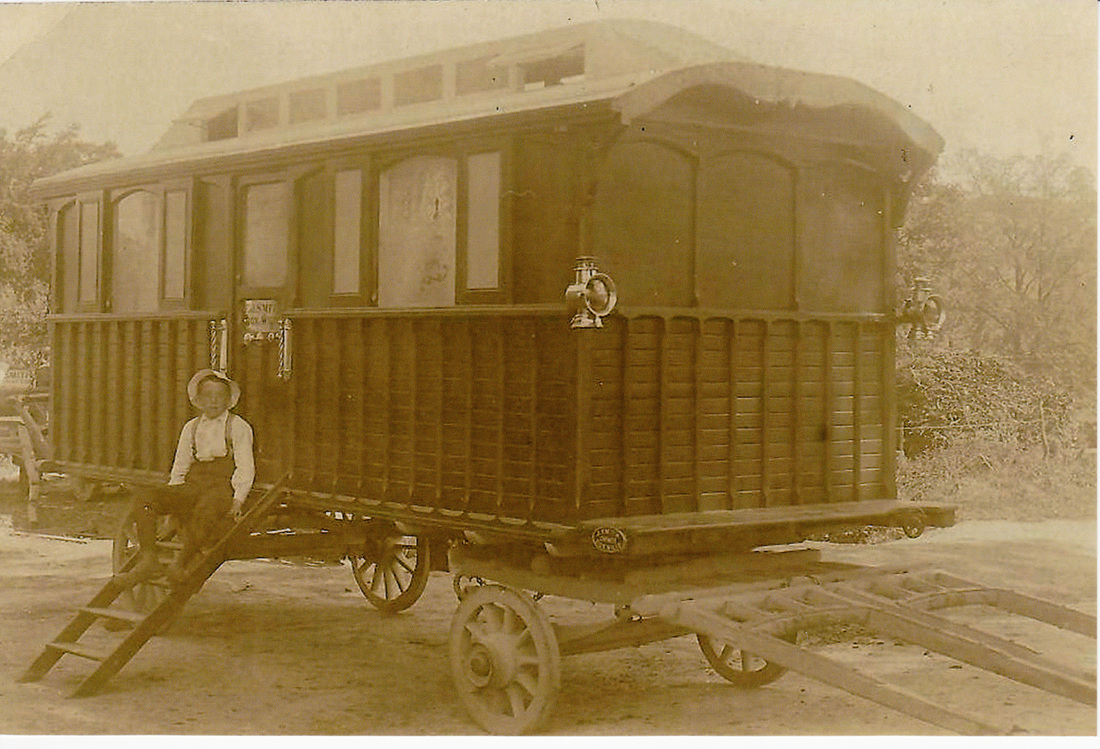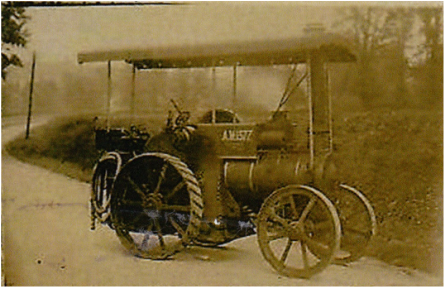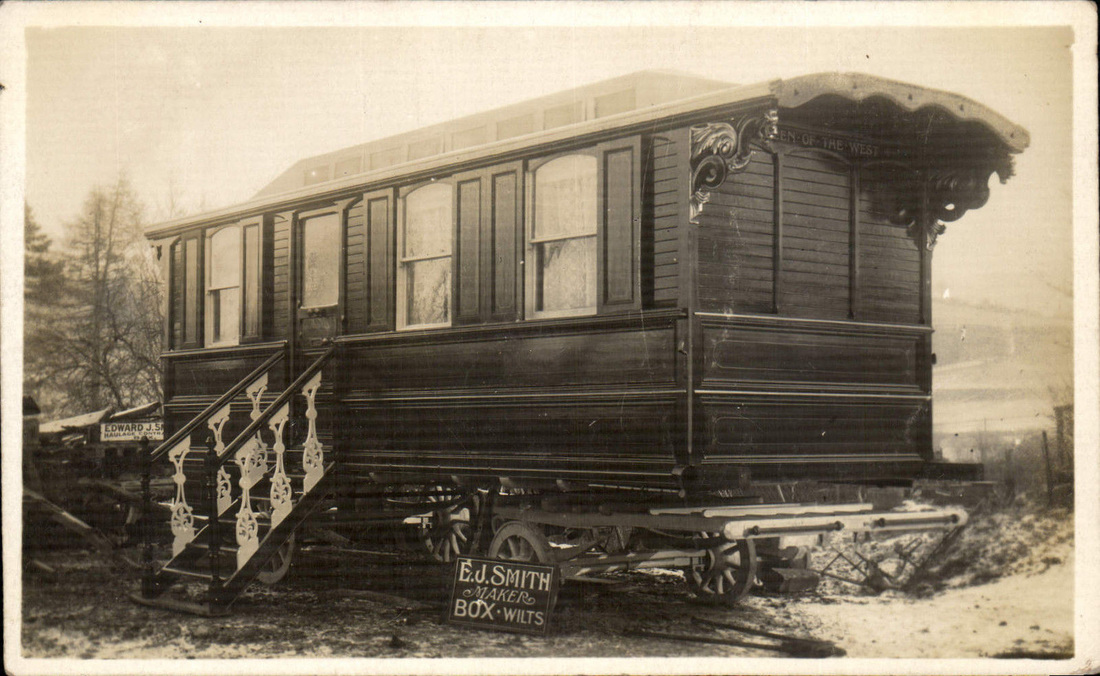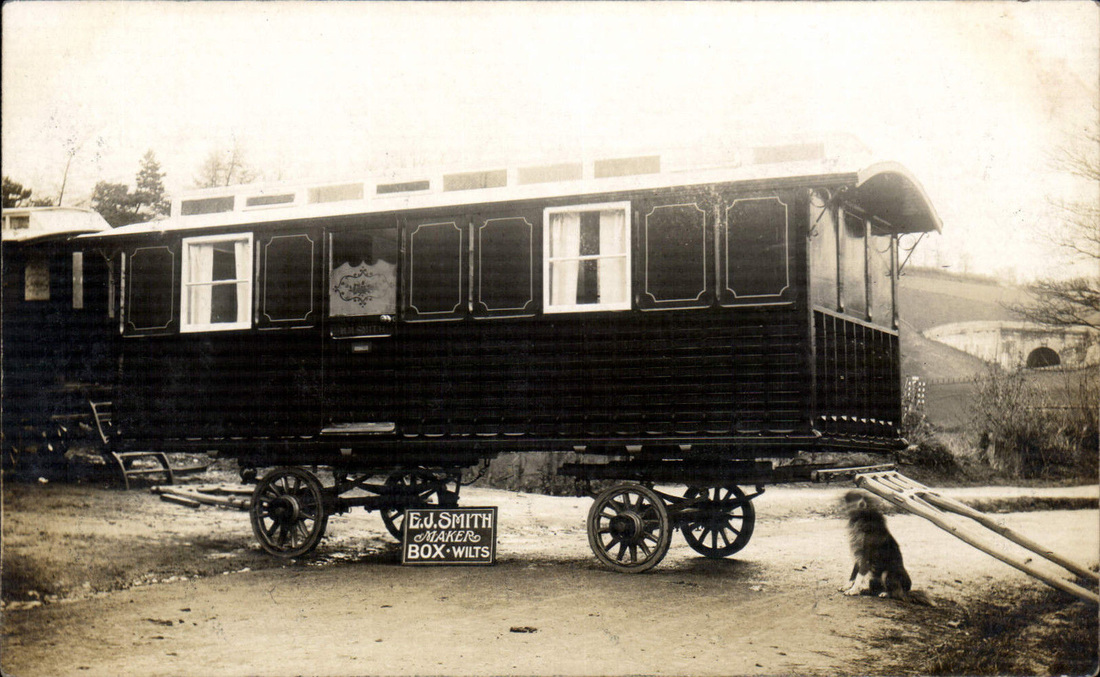|
EJ Smith and Family:
Makers of Caravans Verity Jeffery May 2016 We all love the adventure expressed by Toad in The Wind in the Willows when he said, Here today, up and off to somewhere else tomorrow! Travel, change, interest, excitement! The whole world before you, and a horizon that's always changing! [1] Something in all of us thrills at the sense of adventure on the open road. Photos courtesy Verity Jeffery unless otherwise stated. |
Caravan Adventures Invented
The first holiday caravan was built in Bristol in 1885 for a Scottish gentleman, Dr Stables, who wanted to explore Britain as a Romany gypsy but with every middle class comfort.[2] The caravan was romantically called The Wanderer and pulled by two horses, Captain Corn-flower and Polly Pea-blossom. The first vehicle was such an extraordinary sight that a man would cycle ahead warning other road users. Amazingly this first vehicle was in use until 2007 and is now preserved at the National Motor Museum, Beaulieu.
Shortly after The Wanderer was built, the craze for leisure touring took off and Box became a centre where these amazing vehicles were made at Ashley by the Smith family.
The first holiday caravan was built in Bristol in 1885 for a Scottish gentleman, Dr Stables, who wanted to explore Britain as a Romany gypsy but with every middle class comfort.[2] The caravan was romantically called The Wanderer and pulled by two horses, Captain Corn-flower and Polly Pea-blossom. The first vehicle was such an extraordinary sight that a man would cycle ahead warning other road users. Amazingly this first vehicle was in use until 2007 and is now preserved at the National Motor Museum, Beaulieu.
Shortly after The Wanderer was built, the craze for leisure touring took off and Box became a centre where these amazing vehicles were made at Ashley by the Smith family.
Smith Family
The first reference to the family is in 1868 when James Smith married Jemima Perren of Colerne. The couple had moved to Ditteridge by 1871 where James worked as a carpenter. They had two children: Edward John (1869 - 1931), who was the main developer of the caravan business, and a daughter, Annie (b 1874). By 1881 the family were renting 3 Ashley Villas and James had set up in business as a wheelwright, employing 7 men and 1 boy. Probably Edward John was one of the employees and he was described as a carpenter, whilst his sister Annie worked as a dressmaker.
The first reference to the family is in 1868 when James Smith married Jemima Perren of Colerne. The couple had moved to Ditteridge by 1871 where James worked as a carpenter. They had two children: Edward John (1869 - 1931), who was the main developer of the caravan business, and a daughter, Annie (b 1874). By 1881 the family were renting 3 Ashley Villas and James had set up in business as a wheelwright, employing 7 men and 1 boy. Probably Edward John was one of the employees and he was described as a carpenter, whilst his sister Annie worked as a dressmaker.
Edward John Smith
Aged 23 in 1892, Edward John married a local girl, Adelaide Ford (born 1866 at Cold Ashton, died 1900) who had previously been a parlour maid at The Circus, Bath. They had several children including Edward James (1893 - 1964), Walter George (1895 - 1900) and Herbert Reginald sometimes known as Hubert (1896 - 1952). But in 1899 Adelaide died and was buried in Box on 4 January 1900 and that same year both the son Walter George and grandfather James also died.
Aged 23 in 1892, Edward John married a local girl, Adelaide Ford (born 1866 at Cold Ashton, died 1900) who had previously been a parlour maid at The Circus, Bath. They had several children including Edward James (1893 - 1964), Walter George (1895 - 1900) and Herbert Reginald sometimes known as Hubert (1896 - 1952). But in 1899 Adelaide died and was buried in Box on 4 January 1900 and that same year both the son Walter George and grandfather James also died.
|
Remaining in the family home at 3 Ashley Villas were Jemima, widow, Edward John, widower, and Hubert, grandson, surviving on the income that Edward John earned as a haulier and contractor. Edward John married again at Claverton, Bath in 1903 to Martha Matilda Sumsion (1875 - 1958), a housemaid from Ashley Manor.
All the time the family were building their business at Ashley and seeking to modernise their production processes in what had been a very labour-intensive, craft industry. There were many difficulties in the modernisation plan and two serious incidents on the way. Right: Probably one of the Smith children courtesy Eric Callaway |
|
Damage to Box Highway, 1894
In July 1894 the firm suffered a set back when they were prosecuted by the Chippenham Highway Board for damage to the public highway by taking a vehicle on the road.[3] It appears extraordinary to us but this was 25 years before the road fund licence was introduced and the problem was that the vehicle was a traction engine the firm had bought in August 1893 for the purpose of drawing timber carriages on the road in their business as Timber Dealers. Compared to other road users the vehicle had excessive weight and had caused extraordinary damage which cost more to repair than normal usage. The Board claimed damages of £99.14s.10d but in the end settled for £50 with costs, still a considerable amount. |
Accidental Death, 1913
More trouble beset the firm when an employee, Edward Frederick Currant, of The Bartons, Ashley, was killed in an accident at the sawmill plant.[4] Mr Currant, a bachelor aged 36, was employed as a sawyer by the firm described as EJ Smith, builder and wheelwright. Proprietor of Ashley Steam Sawmills. There are no details of the incident but it could have related to the use of steam power to drive the cutting machinery. It is possible that the same traction engine was involved, off the road but used as the power source for a saw cutting face. The accident brings into doubt where the firm had its sawmill yard. The heavy plant involved would have made it more likely that the yard was in part of the stoneyards behind the railway station, rather than at the site of the white wall on the A4.
More trouble beset the firm when an employee, Edward Frederick Currant, of The Bartons, Ashley, was killed in an accident at the sawmill plant.[4] Mr Currant, a bachelor aged 36, was employed as a sawyer by the firm described as EJ Smith, builder and wheelwright. Proprietor of Ashley Steam Sawmills. There are no details of the incident but it could have related to the use of steam power to drive the cutting machinery. It is possible that the same traction engine was involved, off the road but used as the power source for a saw cutting face. The accident brings into doubt where the firm had its sawmill yard. The heavy plant involved would have made it more likely that the yard was in part of the stoneyards behind the railway station, rather than at the site of the white wall on the A4.
In Box and Somerset
We can see from the photo above right that the caravans were pictured up on a high point on Ashley Lane in order to give an intriguing view of Middlehill Tunnel. But it is unlikely that the workshop and yard were sited south of the A4, where the land is on a sharp incline. It is much more likely that the work was undertaken in part of the stoneyards site and taken across the A4 road for publicity purposes. Perhaps this is what was happening when the highway was damaged in 1894.
Suddenly in 1911 there is a references to Edward John and his wife, Martha, living in The Caravan at Uphill, Weston-super-Mare. Edward John was only 42 and Martha 36, so it is likely that it was financial misfortune or ill-health that drove them into one of their own vehicles. In April 1915 there is an intriguing reference to the family hiring out a two-room caravan at Redcliffe Bay, Portishead.[5] The family seem to have moved down to that area permanently because in 1931 Edward John died at Kewstoke, Weston-super-Mare and in 1958 Matilda Mary died.
Edward James died in 1964 at The Foreshore, Portishead and Hubert Reginald of Leigh View, Portishead, died in 1952 at Chew Magna. Caravans drawn by horse or traction engine have passed into history but the Smith family of Box have left a fascinating glimpse of that era.
We can see from the photo above right that the caravans were pictured up on a high point on Ashley Lane in order to give an intriguing view of Middlehill Tunnel. But it is unlikely that the workshop and yard were sited south of the A4, where the land is on a sharp incline. It is much more likely that the work was undertaken in part of the stoneyards site and taken across the A4 road for publicity purposes. Perhaps this is what was happening when the highway was damaged in 1894.
Suddenly in 1911 there is a references to Edward John and his wife, Martha, living in The Caravan at Uphill, Weston-super-Mare. Edward John was only 42 and Martha 36, so it is likely that it was financial misfortune or ill-health that drove them into one of their own vehicles. In April 1915 there is an intriguing reference to the family hiring out a two-room caravan at Redcliffe Bay, Portishead.[5] The family seem to have moved down to that area permanently because in 1931 Edward John died at Kewstoke, Weston-super-Mare and in 1958 Matilda Mary died.
Edward James died in 1964 at The Foreshore, Portishead and Hubert Reginald of Leigh View, Portishead, died in 1952 at Chew Magna. Caravans drawn by horse or traction engine have passed into history but the Smith family of Box have left a fascinating glimpse of that era.
References
[1] Kenneth Grahame, The Wind in the Willows, first published 1908
[2] http://www.dailymail.co.uk/news/article-2480291/Worlds-oldest-caravan-makes-final-journey.html
[3] The Bath Chronicle, 12 July 1894 and 9 August 1894
[4] Bath Chronicle and Weekly Gazette, 22 February 1913
[5] Western Daily Press, 19 January 1931
[1] Kenneth Grahame, The Wind in the Willows, first published 1908
[2] http://www.dailymail.co.uk/news/article-2480291/Worlds-oldest-caravan-makes-final-journey.html
[3] The Bath Chronicle, 12 July 1894 and 9 August 1894
[4] Bath Chronicle and Weekly Gazette, 22 February 1913
[5] Western Daily Press, 19 January 1931
